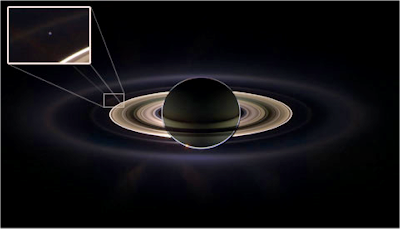Whenever there is some argument in our neighbor's house,we see them as fools arguing on silly matters. We see other states fighting on issues and wonder isn't there other way out? We see other countries fighting and wonder if they would not fight and remain at peace. But what if someone look to us from further beyond,far from the clashing sound of ours. From the distant solar system. What would they see???
Wandering such Carl Sagan wanted one last picture of Earth from "a hundred thousand times" as far away than the famous shots of Earth taken by astronauts from the moon during the Apollo series.
By 1989 both Voyager spacecraft had passed Neptune and Pluto. Taken by Voyager-1 on Feb 14, 1990. At that time Voyager-1 was farther from the Sun than Pluto, and approximately 4 billion miles from the Earth. Thus, NASA gave Voyager 1 one last assignment and had the craft take the first ever pictures of the planets from “outside” the solar system. This image of the Earth is one of 60 frames taken by the Voyager-1 from a distance of approximately 4 billion miles. This image the Earth is a mere point of light, only 0.12 pixel in size. This is a compilation of those shots.
Carl Sagan Narrates: “So here they are, small squares laid down on top of the planets and background smattering by more distant stars. We were able to photograph not only the Earth, but five others of the suns 9 own planets, Mercury diminished in the glare of the sun and Mars and Pluto are too small and/or too far or dimly lit away. Uranus and Neptune are so dim that, to record their presence required long camera exposures.
This is how the planets will look to an alien ship approaching the solar system after long interstellar voyage, from this distance the planets seems only points of light smeared even to the high resolution cameras aboard the voyager, they are like the planets seem to the naked eye from the surface of the Earth, luminous dots brighter than most of the stars over the periods of months. The Earth like the other planets seemed to move among the stars.
You cannot tell only by looking at one of these dots what s on it? What past has been? And weather in this particular epoch anyone lives there. Because of the refection of the sunlight of sun the Earth seems to be sitting on a beam of light as if there were some special significance to this small world, which was just an accident of geometry and optics. The sun emits its radiation equitably in all directions. Had the picture been taken little earlier or little later there would have been no sunbeam highlighting the Earth.
Form this vantage point the Earth might not seems to be of any particular interest. But for us it’s different. Consider again that dot, that’s here---- that’s HOME, that’s US!!!
On it every one you love everyone you ever heard of, every human you know, lived out their lives.
The joys and suffer, thousands of confident religions and ideologies, every hunter and forger, every hero and coward, every creator and every destroyer of civilization, every king and peasant, every young couple in love, every mother and father, every adventurer and explorer, every teacher of moral, every corrupt politician, every super star, every supreme leader, every saint and sinner in the history of our species live there.
On a mote of dust suspended in a sunbeam.
The Earth is a very small stage in a vast cosmic arena. Think of the rivers of blood spilled by all those generals, so that in glory and triumph they can become the momentary masters of a fraction of a dot. Think of the endless cruelties visited by the inhabitants of one corner of this pixel on the scarcely indistinguishable inhabitant of some other corner. How frequent their misunderstandings are? How eager they are to kill one another? How frequent their hatred, posturing their imagined self importance, the delusion that we have some privileged position in this universe are challenged by this point of pale light. Our planet is a lonely spec in a great enveloping cosmic dark, in aura of security, in all this vastness, there is no hint that help will come form outer space to save us form ourselves. The Earth is the only world known so far to harbor life. There is no where else at-least in the near future to which our species can migrate…. Visit yes!!!! Settle not yet.
Like it or not for the moment Earth is where we make our stand.”
Not since NASA's Voyager-1 spacecraft saw our home as a pale blue dot from beyond the orbit of Neptune has Earth been imaged in color from the outer solar system. Now, Cassini casts powerful eyes on our home planet, and captures Earth, a pale blue dot and a faint suggestion of our moon, among the glories of the Saturn system.
This image was taken by the Cassini spacecraft wide-angle camera on Sept. 15, 2006, at a distance of approximately 2.1 million kilometers (1.3 million miles) from Saturn. Cassini was nearly 1.5 billion kilometers (930 million miles) from Earth.
Earth is captured here in a natural color portrait made possible by the passing of Saturn directly in front of the sun from Cassini's point of view. A magnified view of the image …moon is seen as a dim protrusion to the upper left of Earth. Seen from the outer solar system through Cassini's cameras, the entire expanse of direct human experience, so far, is nothing more than a few pixels across.
By July 31, 2009
Voyager’s Distance from the Earth (Km)
Voyager-1: 16,481,000,000
Voyager-2: 13,300,000,000
Cassini is still in orbit of Saturn



